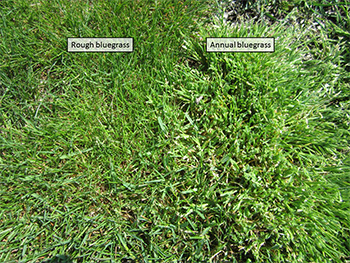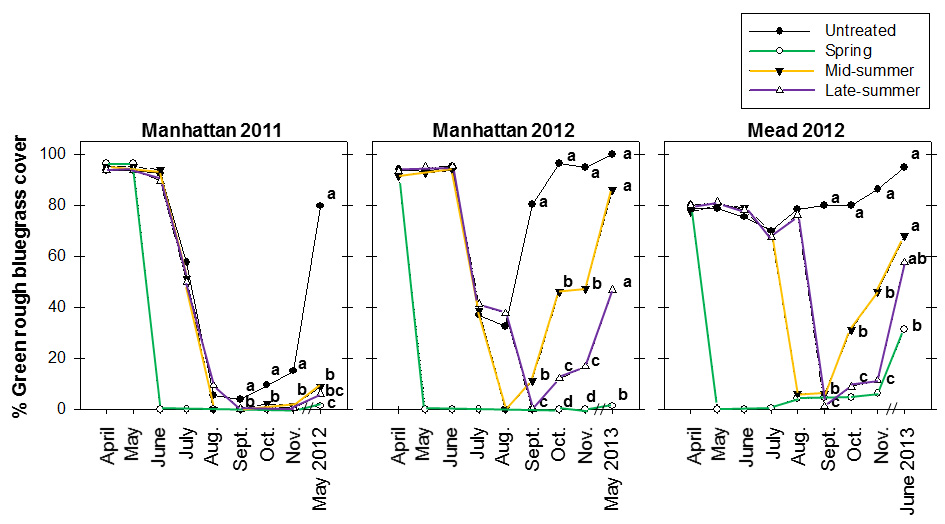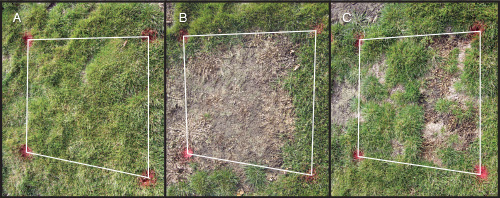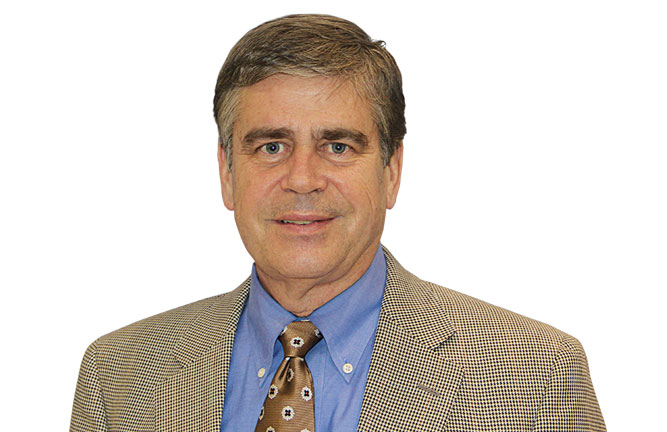Controlling Poa trivialis with glyphosate
By Cole Thompson, Ph.D.; Jack Fry, Ph.D.; Megan Kennelly, Ph.D.; Zac Reicher, Ph.D.; and Matt Sousek

FIGURE 1
Laser Rough bluegrass growing adjacent to annual bluegrass.
Rough bluegrass (Poa trivialis L.) is a cool-season perennial turfgrass commonly encountered in temperate climates because of years of intentional and unintentional propagation. The major commercial uses of rough bluegrass have been for winter overseeding of warm-season turfs in the southern U.S. and for establishment in shaded, moist sites. Unintentional rough bluegrass propagation is thought to occur vegetatively during routine cultivation and from seed lot contamination of desirable species (Reicher et al., 2013).
Regardless of commercial uses, rough bluegrass is most commonly described as a persistent weed in cool-season turfgrasses because of its color, sensitivity to heat and drought stresses compared with other turfgrass species and invasive, stoloniferous growth habit.
Current approaches
Currently, Velocity (bispyribac-sodium) is the only product labeled for selective rough bluegrass control in cool-season turf and is registered for use on sod farms and golf courses only. Multiple applications may reduce rough bluegrass groundcover, but can also injure desirable species (McCullough and Hart, 2011).
Nonselective herbicides are the only other reliable rough bluegrass control options for cool-season turfgrass managers, and the only option in home lawns. Late-summer or fall glyphosate applications would be most practical as they are commonly followed with overseeding. However, rough bluegrass persistence is anecdotally reported after glyphosate application in late-summer, and effective control of other cool-season turfgrass species with glyphosate varies.
Recent research suggests that Kentucky bluegrass (Poa pratensis L.) is best controlled with glyphosate in spring, but tall fescue (Festuca arundinacea Schreb.) control is best following summer glyphosate application (Adkins and Barnes, 2013).
Because glyphosate is currently the most accessible herbicide for rough bluegrass control, the objective of this project was to refine application timing to optimize control.
The experiment

FIGURE 2
Effects of seasonal glyphosate timing on green rough bluegrass cover in Manhattan, Kan., in 2011 and 2012 and in Mead, Neb., in 2012. In Manhattan (2011), applications were made on May 21 (spring), July 26 (mid-summer) and Aug. 25 (late-summer). In Manhattan (2012), application dates were April 23 (spring), July 27 (mid-summer) and Aug. 30th (late-summer). In Mead (2012), application dates were May 4 (spring), July 31 (midsummer), and Sept. 6 (late-summer). On individual dates, means with the same letter are not statistically different according to Fisher’s protected LSD (P ≤ 0.05).
Click on the image to enlarge it.
Replicated field studies were conducted from 2011 to 2013 on rough bluegrass maintained at 2.5 inches at the Rocky Ford Turfgrass Research Center in Manhattan, Kan., and the John Seaton Anderson Turf Research Center in Mead, Neb. Two separate studies were conducted in Manhattan (2011 and 2012) on Laser rough bluegrass. A third study was initiated in Mead on Winterstar rough bluegrass in 2012.
In each study, Glyphomate 41 (glyphosate) was used at 3 lbs a.i. per acre in spring, midsummer, or late-summer. Percent green rough bluegrass cover was visually estimated monthly and analyzed statistically during the growing season and approximately one year after initial spring treatments.
Effect of glyphosate timing
In each study, all glyphosate application timings initially reduced green rough bluegrass coverage to 0 percent, but rough bluegrass recovery varied among application timings.
In Manhattan (2011), glyphosate was applied on May 21 (spring, 96 percent green coverage), July 26 (midsummer, 51 percent green coverage) and August 25 (late-summer, 9 percent green coverage). Untreated rough bluegrass declined to <10 percent cover in september recovered to nearly 20 green by the end of growing season and averaged 80 next spring.
All glyphosate timings reduced green cover to <10 percent in percent in the spring following treatment and spring-applied glyphosate resulted in lower green rough bluegrass cover (1 percent) compared with that applied in midsummer (9 percent) (Figures 2 and 3).

FIGURE 3
Effects of seasonal glyphosate timing on green rough bluegrass cover the spring following treatment in Manhattan, Kan., on May 30, 2012. A) Untreated rough bluegrass; B) rough bluegrass treated with glyphosate in spring; C) rough bluegrass treated with glyphosate in mid-summer.
Click on the image to enlarge it.
Greater rough bluegrass recovery was observed in the studies in Manhattan and Mead. In Manhattan (2012) glyphosate was applied on April 23 (spring, 95 percent green cover), July 27 (midsummer, 38 percent green cover) and August 30 (late-summer, 37 percent green cover). Untreated rough bluegrass declined to approximately 40 percent green cover in August, but had completely recovered by the end of the growing season. The following spring, untreated plots still averaged 100 percent green cover, and only spring applied glyphosate significantly reduced green rough bluegrass cover (1 percent) compared with untreated turf (Figure 2).
In Mead (2012) glyphosate was applied on May 4 (spring, 80 percent green cover), July 31 (midsummer, 70 percent green cover) and September 6 (late-summer, 75 percent green cover). Untreated green rough bluegrass cover never fell below 70 percent and green cover reached 95 percent in the spring following treatment. Only spring-applied glyphosate reduced green rough bluegrass cover (31 percent) compared with untreated rough bluegrass in the spring following applications in Mead (Figure 2).
Practical implications
In this study, glyphosate application in mid- and late-summer temporarily reduced green rough bluegrass cover, but recovery ultimately limited the efficacy of these timings. Mid- and late-summer glyphosate applications may seem effective shortly after application, but results from these studies suggest that glyphosate most effectively controls rough bluegrass when applied in the spring.
Acknowledgments
We appreciate contributions from the Kansas Turfgrass Foundation and the Nebraska Turfgrass Association that partially funded this experiment.
References
Adkins, J. K. and Barnes, T. G. 2013. Herbicide treatment and timing for controlling Kentucky bluegrass (Poa pratensis) and tall fescue (Festuca arundinacea) in cool season grasslands of central Kentucky, USA. Nat. Areas J. 33(1):31-38.
Beard, J. B. 1973. Turfgrass: Science and culture. Prentice-Hall, Englewood Cliffs, New Jersey.
Hurley, R. H. 2003. Rough Bluegrass. Pages 67-75 in: Turfgrass: Biology, Genetics, and Breeding. in: Casler, M. D. and R. R. Duncan, eds. John Wiley and Sons, Inc, Hoboken, NJ.
McCullough, P. E., and Hart, S. E. 2011. Multi-year roughstalk bluegrass control in creeping bentgrass with bispyribac-sodium and sulfosulfuron. Appl. Turfgrass Sci. 2011 doi: 10.194/ATS-2011-0425-01-RS.
Reicher, Z. J., Nees, L. W., and Levy, M. D. 2011. Roughstalk bluegrass contamination in creeping bentgrass seed lots. Appl. Turfgrass Sci. 2011 doi:10.1094/ATS-2011-0422-01-BR.










